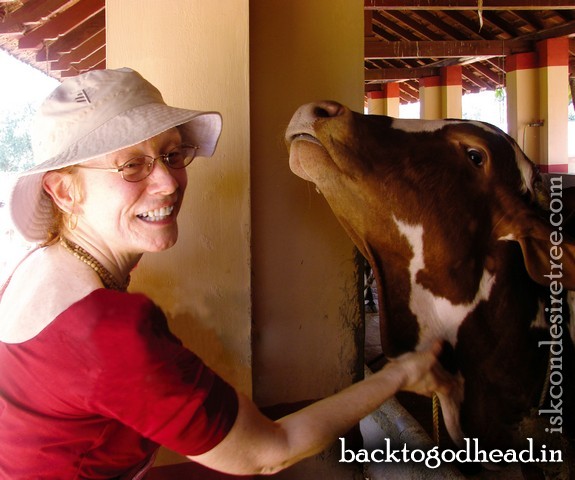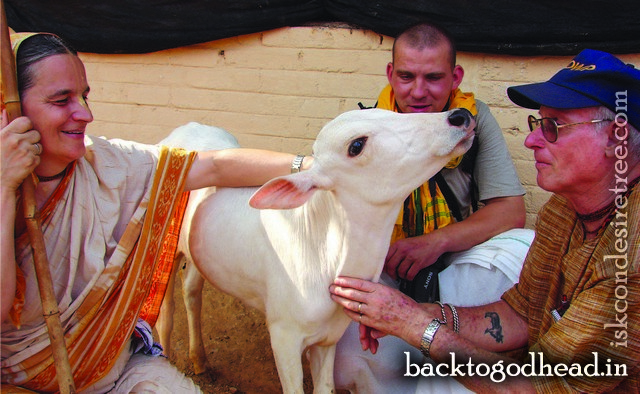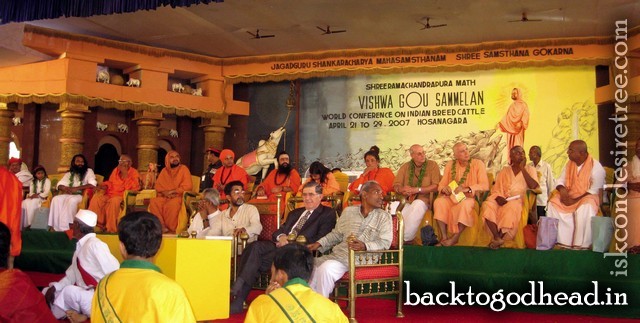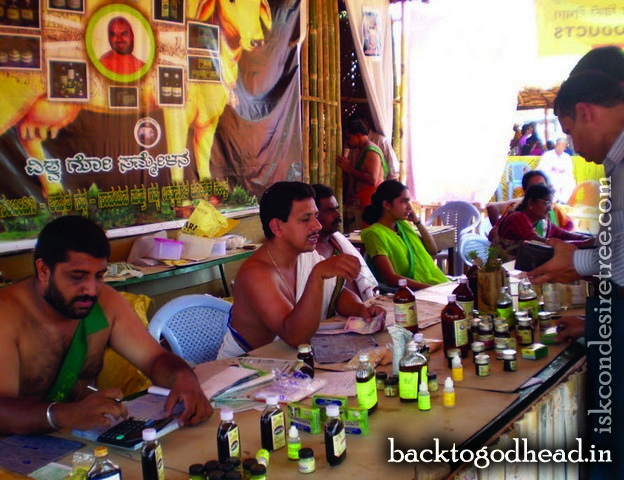
Another Cold, dark day as I broke the ice on the water trough to allow the cows to drink the refreshing well water. Clothed in my Carhart overalls, with vest, scarf, boots, facemask, and insulated gloves, I could last a few hours helping Caitanya Dasa feed out hay in the barn before the pain of freezing temperatures penetrated to my skin. It had been an exceptionally cold week, with temperatures holding at freezing and below.
My husband, balabhadra Dasa, ISKCON’s minister for cow protection and agriculture and chief cowherd on our ISCOWP farm in West Virginia, uSa, was traveling to various cow protection programs in India and europe to encourage, educate, and inspire other cowherds and learn from them as well. While he was away, Caitanya Dasa and I were caring for the cows during the winter.
balabhadra and I incorporated ISCOWP, The International Society for Cow Protection, in 1990. Srila Prabhupada, our spiritual master, inspired us to protect cows throughout their lives so that they could live a peaceful life away from the stun gun and the butcher’s knife. by nature, we both felt a connection with animals and affection for them. but after we learned from Srila Prabhupada the spiritual and material significance of cows, our feelings solidified into action.
While spreading the hay in the feed aisle with a pitchfork, I meditated on the eager faces of Gita, jaya, and asha, three of our beautiful cows. I also thought about the email I had just received from balabhadra from Vrindavan:
Mr. Sadashiv Montimar came from Delhi specifically to meet me. He had come one month earlier to the Krishna-balarama Mandir and spoken with Devamrta Dasa, the temple president, about the Vishwa Gou Sammelan [World Cow Conference], a huge cow conference that his guru and temple are sponsoring in South India. besides doing all of the things we talk about doing, they are protecting and breeding 27 of the remaining 33 Indian breeds of cows left in India.
Mr. Montimar told me that his guru, Shree raghaveshwara bharathi Swamiji, the guru of Shree ramachandrapura Math, quotes from our articles and uses my name as a reference to the quotes. He gave me a lot of literature and a personal written invitation to attend the conference. It is a nine-day conference on all aspects of cow protection. They are expecting a half million people to attend over the nine days. The conference is april 21–29 in Hosanagara. It’s not an undoable time frame, and it would definitely be reaching out to a huge field of new people who are all into cow protection in a big way. I think it is worthwhile.
In the twenty-first century, cow protection is a challenge, requiring a counterculture mindset, and therefore difficult to practice even without freezing temperatures. Cow protection originated in India, a warm climate where the cows can pasture all year long. In such a climate, as long as there’s enough grazing land, there’s no need to grow hay, harvest it, and store it before feeding it to the cows.
Understanding Cow Protection

What exactly is cow protection? Hearing the term, people typically react in two ways. Some think protection is for endangered species, and since there are billions of cows, it’s better to concentrate on whales or the african elephant. Others think “cow protection” may refer to some pagan worship of animals the “sacred cow” image.
The philosophical reason for cow protection is that all living creatures deserve protection from slaughter and other violence at the hands of humans. all animals are souls, the same as we are. They are all children of Krishna, all dear to Him. With this view in mind, animal slaughter can be seen as a form of murder.
The cow is our mother. Vedic philosophy teaches that there are seven mothers: (1) the birth mother, (2) the wife of the spiritual master, (3) the wife of a brahmana, (4) the queen, (5) the cow, (6) the wet nurse, and (7) the earth. The cow is one of the seven mothers because she gives her milk to nourish us.
We should hold all mothers in a position of respect. Since we don’t kill or eat our mother, we shouldn’t kill or eat the cow. Likewise, the bull is our father because he can plow the earth to produce food grains. One does not kill and eat one’s father and mother even when they are old and less economically useful.
five thousand years ago Lord Krishna, the Supreme Personality of Godhead, appeared on earth to protect His devotees and to demonstrate His pastimes. among those pastimes was His childhood role as a cowherd boy. The cows were very dear to Him because of their affectionate and gentle nature as well as their contributions to human society, and in return He was kind to them and protected them. We should follow His example.
Srila Prabhupada writes, “from the Lord’s personal activities, human society should learn how to give protection specifically to the brahmanas and cows. Then the protection of religious principles, fulfillment of the aim of life, and protection of the Vedic Knowledge can be achieved. Without protection of cows, brahminical culture cannot be maintained; and without brahminical culture, the aim of life cannot be fulfilled. (SrimadBhagavatam, 8.24.5 Purport)
Protecting the Bull
In contemporary practice the first principle of cow protection, surprisingly, is ox employment. The cow’s main usefulness is seen as milk production, but she will not give milk unless she has a calf. Half of all calves are bulls and will never produce milk. The expense of feeding the bulls will be a deficit to the farmer unless he realizes their potential for alternative energy by employing them in activities like tilling the fields and hauling. farmers in most countries make money by selling bulls for meat, either directly to the slaughterhouse; to the cattle industry, where they live in crowded feed lots until they are fat enough for profitable slaughter; or to the veal industry, where bull calves live a short life crammed into a tiny crate for sixteen weeks.
The cow is also sold for meat when she cannot produce the required quantity of milk. but regardless of milk production, the dung and urine of a cow or bull is valuable. Instead of slaughtering all bovines that do not produce milk, why not use their dung and urine in fertilizers, compost, medicines, pest repellents, cleaning products, and biogas fuel, to name a few useful and saleable items?
Srila Prabhupada said, “now, practically, in India they accept it, and it has been found by chemical examination, that cow dung contains all antiseptic properties. That is a fact. One Dr. Goshal analyzed [it] in his laboratory . . . , and he found that . . . cow dung is full of antiseptic properties.”
The modern system of agriculture is ignorant of the alternative energy potential of the bull calf and the variety of useful bovine dung and urine products. Therefore, slaughtering becomes the only economically viable means of management. Most people, accustomed to this viewpoint and seeing no alternative, will throw up their hands and agree, even if they prefer a less violent solution. That’s only because they don’t have the facts. They don’t know that the overall value of the ox is greater when he is used for work than when he’s slaughtered for meat, and that even when not productive, a cow or ox produces useful urine and dung.
The Gou Sammelan
after much debate, we decided to attend the conference, mainly to represent Srila Prabhupada in his country of origin. as his american disciples, we would give credence to the power of his teachings. We hoped to attain contacts for spreading cow protection. and we wanted to learn more about cow care, the use of cow dung and urine for medicines, and the efficacy of these byproducts.

Late at night on april 20 we arrived at the Shree ramachandrapura Math, founded by Sankaracarya more than thirteen hundred years ago.
“Hare rama! Gou Mata [Mother Cow]! Hare rama! Gou Mata!” chanted a crowd of the math’s disciples.
We replied, “Hare Krishna! Hare rama!”
Then they chanted back, “Hare Krishna! Hare rama! Gou Mata!”
It was a spiritually potent beginning to an experience of a lifetime.
Shree raghaveshwara bharathi Swamiji has dedicated himself to preserving the indigenous breeds of Indian cows. He has inspired not only the Sammelan but other social, cultural, educational, and environmental programs, many based on cow protection. One example is the math’s Goubank, which gives Indian cattle to people on the condition that they will not sell them, crossbreed them, or practice artificial insemination. The bank accepts cattle when farmers find it difficult to maintain them. This helps the rural farmer and also helps Swamiji achieve one of his objectives: to educate Indian farmers and others about the benefits of rearing and protecting Indian cows.
Throughout the nine-day conference, scientists, doctors, lawyers, farmers, activists, cow protectors, and other experts from around the world gave lectures, presenting their knowledge and understanding of cow protection. Some of the topics: scientific research and analysis related to the uses of cow urine; medicinal values of products of Indian-breed cattle; the role of indigenous cattle in organic agriculture; the relevance of bullock draught power in Indian agriculture and rural transport; and opportunities for cow-related products as an industry.
The Sammelan took place on approximately two hundred acres. On display were the twenty-seven Indian breeds the members of the math protect and breed for preservation. There were also exhibits of ox-powered machines and equipment; household items run on cow urine; cow urine and dung medicinal and beauty products; cow-related sculptures and paintings; and plays, music, and other forms of entertainment centered on the cow.
Our tour guide and president of the ramachandrapura Math, M.K. janardan, showed us reproductions of ISKCON Krishna paintings in the exhibition hall. He said the math’s members recognize Lord Krishna as a cowherd boy and an example to be followed. When the Vishwa Gou Sammelan ended, Shree raghaveshwara bharathi Swamiji announced the building of the world’s tallest statue of Lord Krishna in front of the math in appreciation of the event’s success.
Spiritual Contribution

balabhadra gave two lectures, one before a thousand people. He emphasized Srila Prabhupada’s vision of cow protection.
“absolutely extraordinary speech,” said Sunil Mansingha, chairman of one of the symposium sessions. “for the first time, a speech only about the spiritual aspect of cows. I feel so encouraged due to your enlightenment.”
Mr. Mansingha is also the coordinator of the Govigyn anusandhan Kendra in nagpur, an organization that conducts scientific research on the efficacy and use of cow dung and urine in medicines and other products. Later, balabhadra received an award for his spiritual contribution. balabhadra encouraged devotees from various ISKCON farms to attend the conference. Some of the devotees who attended were Govindanandana Dasa and radha Kanta Dasa from the ISKCON Hungary farm and Hrimati Dasi and Dr. nanda Krishna from ISKCON Mayapur, India. balabhadra and the devotees who accompanied him received much press coverage. “Cow Protection, ISKCON fully behind” was the translated title of one article. It appeared in several newspapers after a thirtyminute press conference that featured
balabhadra showing his arm tattoos of an Indian cow and Lord nityananda’s lotus feet. radha Kanta, Govindanandana, and I appeared in several newspapers as “experts who have forayed into the field of cow protection and organic farming from Hungary and the usa.” We even had people come up to us and ask for our autographs, telling us they had seen us on TV. We were pleased to be representing Srila Prabhupada, Lord Krishna, and the importance of cow protection.
We left the Vishwa Gou Sammelan once again reminded of the Indian culture in which the majority of the population consider the cow sacred and not meat for their hamburger. The association of thousands of people who came to the ramachandrapura Math to honor the cow helped us face the challenge of presenting cow protection in the West.
To learn more about ISCOWP and the Vishwa Gou Sammelan, visit iscowp.org
